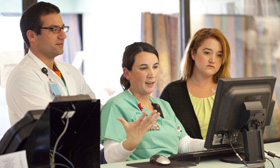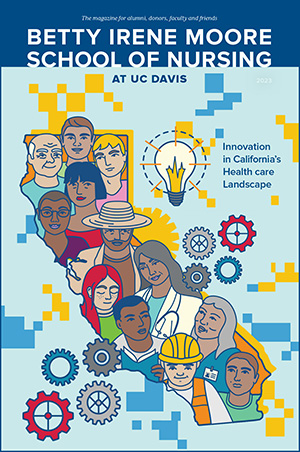Student distinction
Student develops innovative job shadowing program that brings together medical students and nurses

A medical student, nurse and Betty Irene Moore School of Nursing master's-degree student Amy Doroy discuss the necessity of interprofessional education across all disciplines.
Editor's note: This story was first published in fall 2011. As of June 2012, Doroy is an inaugural master's-degree graduate of the School of Nursing. As of fall 2012, she continues her studies at the Betty Irene Moore School of Nursing within the Nursing Science and Health-Care Leadership Doctor of Philosophy Program.
In her first year as a graduate student at the Betty Irene Moore School of Nursing, Amy Doroy developed a unique job-shadowing program where medical students spend a day with registered nurses in a critical care unit at UC Davis Medical Center, where she is also a nurse manager. The experience was part of a School of Medicine pilot program, the 2011 Race and Health Institute.
“The students had great experiences because they learned so much about nurses’ scope of practice,” Doroy said. “Nurses have broad roles with education and experiences in the sciences.”
She said medical students also provided positive support for the program.
“I want to be a physician that is very involved in my patient’s care,” reported one medical student. “I want to be a physician who knows my patients as well as the nurses do. I want to be a physician that is respectful to the people I work with and remember their value.”
Doroy, a master’s-degree student in the Nursing Science and Health-Care Leadership Graduate Program, said the project was one effort toward her goal to advance health through interprofessional education where health professionals learn multiple perspectives to work and communicate as teams.
Doroy first came to UC Davis Medical Center as a nurse 13 years ago. She remembers UC Davis School of Medicine interns shadowing nurses through a now-discontinued program, and said the medical students responded well to the experience. She said the long-term benefits of such interprofessional opportunities include the development of mutual understanding of roles and trust among health-care professionals, which leads to stronger teamwork and collaboration.
Beyond shadowing experiences, Doroy plans to study other educational opportunities to build and strengthen team work among nurses and physicians. She said the Race and Health Institute is an important component to this because the program addresses hierarchies in health status, as well as hierarchies in the health-care system. Such hierarchy is often related to problematic power dynamics among team members and prevents effective collaboration. She said the growing interprofessional education and research programs at UC Davis Health are building strong health-care teams.
“It never made sense why medical and nursing students are educated separately,” Doroy said. “The best solution is to provide meaningful classes together on topics that relate to both professions. I’m excited to see this happening at the UC Davis Schools of Health and to participate in health informatics, public health and cancer care classes with other students.”
After interviews with the 2011 Race and Health Institute students and the nurses they shadowed, Doroy compiled data from the participants for her thesis. Her abstract, “Building Strong Interprofessional Teams: Effects of a Nurse/Medical Student Shadowing Experience,” was selected by the Alliance for Academic Medicine for a poster session this October. Much of this presentation is the basis for her final thesis for her master’s degree in Nursing Science and Health-Care Leadership from the School of Nursing.
Doroy plans to explore more opportunities to expand interprofessional education at UC Davis Health and provide evidence that it leads toward improvements in health care. Based on the success of the 2011 Race and Health Institute, Doroy plans to repeat the shadowing experience for more medical students in October through another program while she also collaborates with faculty to design the 2012 Race and Health Institute.
The Race and Health Institute is part of the $1.7 million Transforming Education and Community Health for Medical Students grant funded by the federal Health Resources and Services Administration. Tonya Fancher, an associate professor in the School of Medicine’s Division of General Internal Medicine, is the principal investigator of the program. The program is offered to first-year medical students who indicate an interest in pursuing a primary-care career in urban underserved areas, and provides a variety of experiences to encourage their continuance in that career trajectory. School of Nursing Assistant Adjunct Professor Jann Murray-García directs the Race and Health Institute with Fancher and colleagues.





